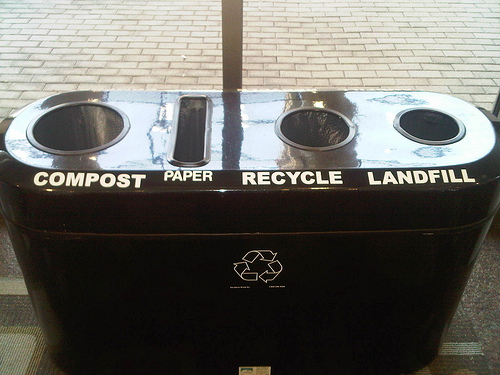Composting: How to Do It and Why It Matters
Posted: July 26th, 2013 | Author: jimmurray | Filed under: Composting, Green Communities, Green Home, Green Technology | Tags: business recycling, carbon footprint, community gardens, compost bin, compost uses, composting, food scraps, gardening, office recycling, recycling, reducing waste, trash | No Comments »This is a guest blog from writer Chloe Trogden. Thanks Chloe

Image by Chris Breikss via Flickr
Every year, we generate about 250 million tons of trash in the United States, according to the Environmental Protection Agency. That’s a lot of waste, and it has to go somewhere. A lot of the chemicals and other toxins in our waste can end up in the ground and the water supply, contaminating our food or drinking sources. In addition, all that waste is contributing to the depletion of natural resources.
Recycling is one way that people have started to reduce the amount of waste produced, but it’s not enough. We need to recycle more, and we need to compost more. The EPA estimates that 87 million tons of material are recycled or composted each year. However, if each household and small business made a commitment to composting, that number could improve dramatically.
How to Compost at Home
Composting is very easy to do at home. You need to set up a compost bin in your yard, which you can either build yourself or buy from a home improvement store. The bin should be enclosed except for an open bottom and a removable top. You can build a pallet out of wood or an old trashcan.
You can put a wide variety of materials into your compost bin, but they should consist of a mix of “greens” and “browns.” Greens include kitchen scraps (except for meat), grass clippings, weeds, and other nitrogen-based materials. Browns include dead leaves, cardboard, newspaper, sticks, branches and other carbon-based materials. Simply put these materials into the bin and leave them to compost.
Keep your compost pile active by adding new materials regularly and turning it with a pitchfork or shovel about once a week. Water it about once a week, as well, to help activate the pile. If you keep the pile fed and activated, you should have a rich, nutrient-dense compost to add to your garden or your lawn in about three to four months.
How to Compost for Your Small Business
No matter what type of small business you have, you can also compost your waste. Traditional office environments will have plenty of paper materials to add to the compost bin, which can be supplemented by scraps from employees’ lunches and clippings from office plants. Businesses that serve food stuffs can supplement their steady supply of scraps with old receipts, waste paper from old files, and cardboard boxes from shipments.
By composting, businesses can help to reduce their carbon footprint and conserve resources. Cafes and restaurants can use the compost to grow a small garden to supplement their supply. Other businesses can donate the compost to local community gardens or farms, helping to give back to the community.
The Benefits of Composting for Everyone
Composting helps to recycle materials that might have otherwise ended up in the landfill, taking up precious land, requiring the use of natural resources and manpower to transport and process the waste, and potentially ending up contaminating the water supply. You can help to reduce your carbon footprint as an individual or as a business by composting what you can to turn that waste into something useful and to reduce your consumption of natural resources.
Individuals can also save money by composting. They can use it in place of fertilizer or garden soil, and they can grow bigger and more nutritious vegetables. Small businesses that are in the food industry can do the same.
Composting is a great way to reduce your waste and maybe to even save a little money. It’s easy to do, and it can make a big impact. Consider composting in your home or even your business to start reaping the benefits.
Bio:
Chloe Trogden is a seasoned financial aid writer who covers specific opportunities such as grants for minority students. Her leisure activities include camping, swimming and volunteer work.